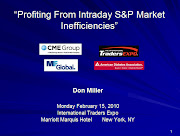4:00pm Quite the choppy and highly illiquid late afternoon as ES frustrated many PM breakout traders before the VIX finally got off the fence and helped push ES up into the close. At this end, I gave back some of the AM profits as getting a solid afternoon entry was like trying to catch a greased pig (I just missed a prime late day entry, but rarely ever chase and let it go), but still managed to retain about 80% of earlier day gains and end with a respectable -- albeit not spectacular +$15K on 1,248 x 2 trading. Suffice it to say it's unlikely I'll ever be a strong trader in the last hour!
In terms of today's earlier action and charts, 1st pullbacks remain the highest -- and sometimes only paying trend entries as the market plays out its current range game, and the shorter timeframe the better. 850 seemed to be pivotal several times in today's ES trade, as it went back and forth between resistance and support several times during the session. In the meantime, the ADX on all major trends including 15, 30, and 60-minute continue to drop.
-----------------
It will certainly be interesting to see how this month ends from a personal performance perspective, in part because I'm really taking somewhat of a mental break in terms of not trading Europe aggressively (if at all on many days), while continuing to trade ES rather modestly during the U.S. session.
As I mentioned last week and in the video over the weekend, the "fire in the belly" just isn't what it was one ... two ... eleven months ago as we approach the end of this 365 day marathon. And if you caught Michael Phelps' interview on 60 Minutes on Sunday, there's an interesting continuing parallel in that he confessed he had very little left in the tank before and during his final races.
And while I can certainly ramp up both the intraday interest and focus when needed for particular sequences (I took an excellent stop on the post Beige Book short covering rally back through 850), I'm finding I just can't keep it up for prolonged periods as I could for much of the last 11 months -- and especially the last three. I suppose such are the temporary scars of "going for it" when the market shifted into its Sep-Nov overdrive for traders. As a result, I'm trading far fewer liquidity-providing wholesale trades and passing on scalp opportunities I might have taken when the market was more fertile.
I have no doubt my prolonged bouts of sharpness will recover, yet in the meantime I continue to play a rather protective game throughout the month as I as I continue to consider any December gains a performance bonus of sorts, or perhaps more appropriately, final leaves on the Chinese Bamboo to keep our year-long analogy in tact.
Wednesday, December 3, 2008
Subscribe to:
Post Comments (Atom)
















5 comments:
Don - Why do you think you'll never be a good late day trader? Is it because your favorite setups don't appear as often? Or is because you aren't as sharp after a full day of trading? It seems to me that over the past couple of months the last hour of the day has delivered some of the best trend trades in years.
Anonymous -
Probably because I'm often up at 3am, am mentally sharpest in the morning, and am usually tired after putting in as many as 13 hours in the day :-).
In addition, a decade of trading has proven to me the last hour is often the most unpredictable as positions are squared, especially compared to the first hour, and the far higher probability sequence is on the morning after a strong closing trend. (As I've mentioned throughout the blog.)
Keep in mind I don't "ride" trends and never will ... I instead prefer the higher probability wholesale fades on extreme emotion. And if there's a strong trend at the end of the day, there's little time for the market to "come back in" ... which typically happens the next morning.
Good question.
Don
Hi Don,
When you fade extreme emotions, how do you time your entries. Is it extreme Tick readings alone or you have some key Pivots you look at too. Your fade entries are aggressive ( buy in anticipation of a turn on extreme tick readings) or conservative ( let the bottom hold first, may be make a higher low, or see a momentum divergence first)? Also if you could throw some light on your trade management strategy - do you have an initial stop (3 points S&P seems like the industry norm)? How much time to do you allow the trades to work before you decide to scratch? Do you use scale in order or all at once, do you scale out of your positions or exit all at once?
Hi Niraj -
Of course I'll start by again saying "it's just what I do" and there are many ways to skin the cat :-).
Now that we've dispensed with the standard disclaimer, here are my thoughts.
I hate to say it's feel, but it really is, combined of course with a combination of technicals. But forgetting about the charts for a minute, it's most important to answer the question, "when is the pain causing the losing traders to panic temporarily over", with emphasis on "temporarily" as fades can be contra-trend scalps only.
By being on the losing end of the trade years ago, you just "know" when you were the one that finally gave it up at the top or bottom. All the charts do for me is confirm the feel.
"Fading" is also relative. i.e. is fading a 1- or 2-min up move into a 15-min brick wall facing the other way a true fade? Then there's the type of move. On a hard push out of consolidation (like Thurs 12/4), I'm not looking to fade the break.
Yet I'd categorize 75+% of my trades as fading, meaning buying on the bid or selling on the ask, so I usually don't wait for divergences on significant moves for scalps. [Divergences are great, but for reversals and not emotional extremes ... just another type of trade].
Suffice it to say I do certainly look at trend supports on larger timeframes, extreme TICK readings, etc., and if they're all saying the same thing, all the better, but I suppose the best chart visual for me is a large bar that simply isn't sustainable and where the price is likely to revert toward the mean.
In terms of trade management, I manage risk primarily via trade size instead of stops, and I scale in and out of 99+% of my trade sequences. And until I feel I'm 100% sized, I don't view a stop as appropriate unless I've really screwed up the entry or unless the market does a complete 180, which it did today (Thurs 12/4) on the afternoon bull trap.
On scratch time, I'm impatient and will often scratch and reenter if it's not moving quickly. Lots of room for improvement there still :-).
Some thoughts anyway.
Don
Thanks Don for a wonderful reply! Although every one is wired differently and what works for you may not work for others, I am sure lot can be learned from the approach taken by a professional trader like you!!
Post a Comment